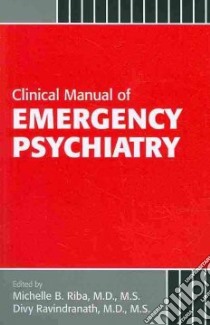- Libreria
- >
- Libri in lingua
- >
- Medicina
- >
- Psichiatria
Clinical Manual of Emergency Psychiatry - 9781585622955
Un libro in lingua di Riba Michelle B. (EDT) Ravindranath Divy M.D. (EDT) edito da Amer Psychiatric Pub Inc, 2010
- € 51.60
- Il prezzo è variabile in funzione del cambio della valuta d’origine
One of the most challenging clinical settings any psychiatrist faces is in the area of psychiatric emergency services. Clinical Manual of Emergency Psychiatry is designed to help medical students, residents, and clinical faculty chart the appropriate course of treatment in a setting where an incorrect assessment can have life and death implications.
Written collaboratively by residents, students, and faculty from various departments of psychiatry in the United States and Canada, Clinical Manual of Emergency Psychiatry covers those topics that are generally the most important and practical in any busy psychiatric emergency department. Equally important, the chapters are arranged by chief complaint rather than by psychiatric diagnosis, and each contains an important summary that can provide clarity quickly when seconds count. This format gives the trainee the ability to quickly find key points for treating the clinical situation. In addition, this text serves as a backup to faculty, and combines the approach of accomplished psychiatry trainees with the views of senior practitioners in the field.
Trainees working in the high-stress psychiatric emergency setting often only have backup supervision by phone rather than in-person oversight. Evaluation of patients in busy psychiatry emergency departments, where first- and second-year residents are quickly trying to address complicated clinical situations with patients who are very ill, is a challenging and difficult process. In response to the specific demands of the psychiatric emergency setting, the authors, under the editorship of Drs. Michelle B. Riba and Divy Ravindranath, made this manual easy to read and clearly focused on presenting complaints. In Clinical Manual of Emergency Psychiatry, trainees and faculty will find:
- ? Case vignettes of applicable clinical scenarios.? A reflection of widespread practices in various academic centers.? Chapters arranged by chief complaint rather than psychiatric diagnosis.? Key point summaries at the end of each chapter.? An integrated perspective from trainees and experienced psychiatrists.
In addition, many of the chapters in this book underscore the potential for medical mimics to cause the presenting complaints, including anxiety, depression, psychosis, catatonia, and cognitive impairment. The recognition that comorbid conditions are often present is critical to the complete assessment of patients in a psychiatric emergency setting.
This book is a must-have for any psychiatric trainee or faculty who works in the often tense and high-stakes psychiatric emergency setting. Patients and families are anxious and fearful, and available clinical information may be sparse or unavailable. The guidelines and approaches outlined in this handbook will be useful to psychiatric students and teachers alike as they work to provide excellent care in the difficult clinical psychiatric emergency situations they encounter.
Informazioni bibliografiche
- Titolo del Libro in lingua: Clinical Manual of Emergency Psychiatry
- Lingua: English
- Autori : Riba Michelle B. (EDT) Ravindranath Divy M.D. (EDT)
- Editore: Amer Psychiatric Pub Inc
- Collana: Amer Psychiatric Pub Inc (Paperback)
- Data di Pubblicazione: 16 Aprile '10
- Genere: MEDICAL
- Argomenti : Psychiatric emergencies Handbooks, manuals, etc Emergency Services, Psychiatric methods Emergency Services, Psychiatric organization & administration
- ISBN-10: 1585622958
- EAN-13: 9781585622955


